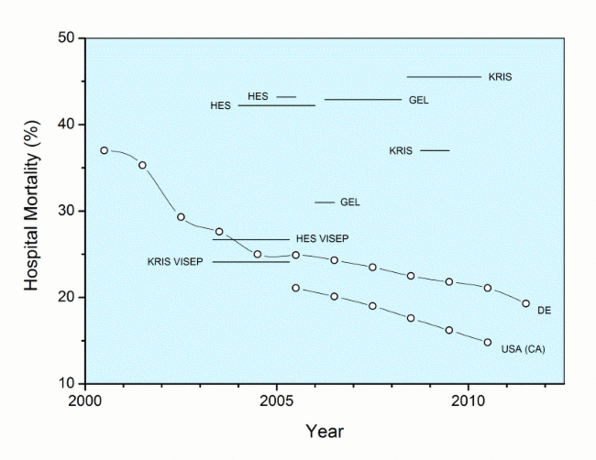
Caution! Jena (Germany)
In-hospital mortality of patients with severe sepsis
The infusion regimen used by the Jena University Hospital of Anesthesiology and Intensive Care, Surgical Intensive Care (Jena, Germany) was changed from January 2004 to April 2010 from various colloids (HES, gelatin) to crystalloids in order to reduce the mortality of patients with sepsis.
We investigated whether this goal had been achieved, based on the following publications:
- Information published by the German Federal Statistical Office (Statistisches Bundesamt: Diagnosedaten der Krankenhäuser ab 2000, Fälle/Sterbefälle) for 678,029 patients, from which we summed up the mortality data listed according to ICD10 of A40 Streptococcal Sepsis (3-7 % of all cases of sepsis) and A41 Other Septicaemia for each of the years from 2000 to 2011 and calculated the weighted means.
- Information for California (USA) on a total of 1.2 million patients for the period from 2005 till 2010 [Banta et al. 2012].
- Data from the German multicentre VISEP study designed in Jena for the period from 04/2003 till 04/2005 [Brunkhorst et al. 2008].
- All publications dealing with the gradual change of the infusion regimen for patients with sepsis in Jena:
Treatment primarily with hydroxyethyl starch (HES):
01/2004 - 01/2006: 360 patients [Bayer et al. 2012]
01/2005 - 06/2005: 118 patients [Schabinski et al. 2009, Bayer et al. 2011]
Treatment primarily with gelatin (GEL):
01/2006 - 06/2006: 87 patients [Schabinski et al. 2009, Bayer et al. 2011]
03/2006 - 03/2008: 352 patients [Bayer et al. 2012]
Treatment primarily with crystalloids (KRIS):
09/2008 - 06/2009: 141 patients [Bayer et al. 2011]
05/2008 - 04/2010: 334 patients [Bayer et al. 2012].
All these data are combined in the Figure “Hospital mortality from sepsis”.

Fig. Hospital mortality from sepsis in the years 2000 to 2011 in Germany (DE) and in the USA (CA) compared with the data from Jena for the periods published, in which primarily hydroxyethyl starch (HES), gelatin (GEL) or crystalloids KRIS) were used as solutions for infusion.
Conclusion
- Despite a 3.7-fold increase of sepsis diagnoses in Germany from 2000 till 2011, mortality from sepsis decreased continuously and even fell below 20% in 2011.
- In the USA (California), mortality from sepsis decreased continuously as well; with 15% in 2010, it was even markedly below the data for Germany.
- The mortality data of the German VISEP study are close to the mean mortality of that time and are well positioned (only the (less favorable) values of the 28-day mortality are available).
-
The actual mortality data (2010) for Jena should be discussed in relation to the data for Germany as well as the US (CA), although the infusion regimen was said to be improved – without informing the patients beforehand? No positive effect can be seen from the change from HES to GEL and KRIS.
References
Banta JE, Kamlesh PJ, Beeson L et al.: Patient and hospital characteristics associated with inpatient severe sepsis mortality in California, 2005 - 2010. Crit Care Med 2012; 40: 2960 - 2966
Bayer O, Reinhart K, Sakr Y et al.: Renal effects of kolloids and crystalloids in patients with severe sepsis: A prospective sequential comparison. Crit Care Med 2011; 39: 1335 - 1342
Bayer O, Reinhart K, Kohl M et al.: Effects of fluid resuscitation with synthetic colloids or crystalloids alone on shock reversal, fluid balance, and patient outcomes in patients with severe sepsis: A prospective sequential analysis. Crit Care Med 2012; 40: 2543 - 2551
Brunkhorst FM, Engel C, Bloos F et al.: Intensive insulin therapy and pentastarch resuscitation in severe sepsis. N Engl J Med 2008; 358: 125 - 139
Schabinski F, Oishi J, Tuche F et al: Effects of a predominantly hydroxyethyl starch (HES)-based and a predominantly non HES-based fluid therapy on renal function in surgical ICU patients. Intensive Care Med 2009; 35: 1539 - 1547
